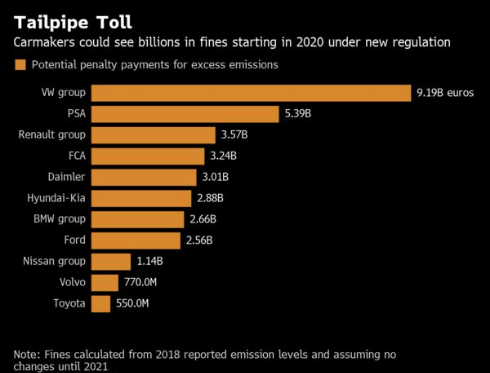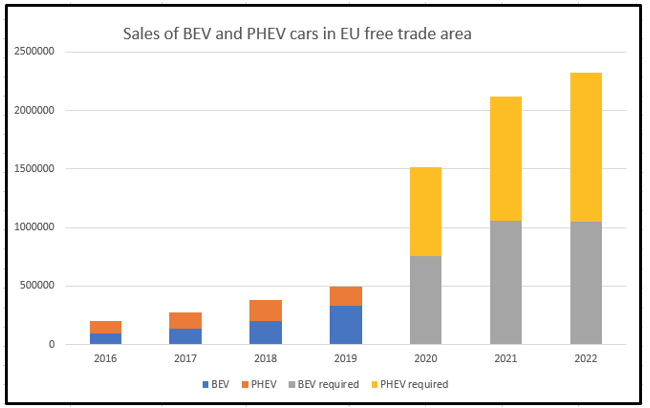Starting next year, the European Union will begin new carbon emission standards for auto manufacturers, which could face fines of up to €33 billion ($37 billion) for failure to comply. As a result, auto manufacturers are rushing to bring hundreds of new battery-electric and hybrid models to market regardless of whether the public wants to purchase them. Auto manufacturers will need to sell about 1.5 million battery electric vehicles and plug-in hybrid electric vehicles next year—an estimated 3-fold increase over this year’s sales. The emission penalties will add about $2,700 to the cost of a new internal combustion car as manufacturers rebalance pricing to sell more electric vehicles.
Beginning next year, new passenger cars sold in Europe will have to emit, on average, no more than 95 grams of carbon dioxide per kilometer. To meet that mandate, a car would have to get about 57 miles per gallon. Carmakers will have until the end of 2020 to meet the gram per kilometer mandate, which will decline another 15 percent in 2025, and again for a total decrease of 37.5 percent by 2030. Each manufacturer can offset the impact of the law by offering vehicles that emit no carbon dioxide directly, such as electric vehicles. The law allows carmakers to buy unused emission quotas from other companies, such as Tesla. Fiat Chrysler Automobiles NV has an agreement with Tesla to pool their vehicles on paper and lower the former’s average fleet emissions, which could save €1 billion in fines. Toyota may also be able to sell credits.
Analysts estimate the industry’s total costs of meeting targets, by ramping up electric-vehicle production and buying carbon credits, at about €15 billion, which would be cheaper than paying the fine. The sale of a battery-electric vehicle can reduce penalties by as much as $20,000.
The Regulations
At the end of 2013, the European Parliament and the Council of the European Union reached an agreement on carbon dioxide emissions regulations from autos. The regulations are phased in starting in 2020 when 95 percent of a manufacturer’s sales must be included in the calculations. In 2021, all cars are included.
Higher emissions are allowed for heavier cars—the allowance is increased by 3.3 grams of carbon dioxide per kilometer for each 100 kilograms of mass above 1,390 kilograms. The penalty for exceeding the targets is €95 per gram per car. The table below summarizes the status of each manufacturer’s emissions as of 2017.

The chart below is an estimate of the penalties that would be imposed on each of the major car manufacturers if their emissions and sales remain the same as they were in 2018.

Impact of “Dieselgate”
Auto manufacturers were making progress towards the mandate until the Volkswagen “Dieselgate” scandal made diesel engines less popular. For years, European automakers sold diesel engines, which emit less carbon dioxide than gasoline engines. Sales of diesel-powered vehicles collapsed, however, after Volkswagen was found cheating on diesel pollution tests.
Diesel’s share of new car sales in the European Union fell from around 60 percent before “Dieselgate” to 32.2 percent by the end of March 2019. Consumers switched from diesel cars to gasoline-powered cars, which accounted for 59.3 percent of European new car sales in the first quarter of 2019. Since 2017, carbon dioxide emissions from vehicles have been increasing in the European Union—the first time in a decade that gasoline-powered vehicle sales surpassed diesel. That leaves automakers with few alternatives other than to produce as many electric vehicles as possible.
Estimates vary for how many electric vehicles are needed to meet the mandate. Peugeot has indicated that it needs 7 percent of its fleet to be electric to meet the 2020 mandate, which is about three times the share of electric vehicles sold in Europe today. In the first three months of this year, plug-in electric vehicles accounted for 2.5 percent of new car sales.
To reduce the penalties, auto manufacturers are introducing new battery-electric and plug-in hybrids next year. Forty-eight new plug-in hybrids and 65 new battery-electric models will become available in the European market in 2020.
Auto suppliers have negotiated a scheme with the authorities where they will be able to count each battery-electric and plug-in hybrid that has an emission rating below 50 grams carbon dioxide per kilometer as two cars. These “super-credits” will help manufacturers meet regulations for the next three years after which they will be phased out. Super-credits can only decrease the average by up to 7.5 grams carbon dioxide per kilometer, which adds 7.5 grams to each supplier’s mandated level. Super credits will count as 1.67 and 1.33 cars in 2021 and 2022, respectively. To avoid penalties, auto suppliers will have to sell approximately 750,000 battery electric vehicles and 750,000 plug-in hybrid electric vehicles in 2020 or some equivalent combination of them.
The Current and Future Market for Electric Vehicles
European sales of battery-electric and plug-in hybrid electric vehicles is expected to increase from 200,000 in 2016 to an estimated 500,000 in 2019. The chart below shows this growth compared to what is needed to absorb the anticipated supply in 2020 and beyond. The blue and orange bars show the growth in sales of electric (BEV and PHEV) vehicles since 2016. (The 2019 value is first-half sales times 2.) The grey and yellow bars show the growth needed if manufacturers are to avoid penalties. Government policies, such as additional subsidies, could help to expand the market. Also, manufacturers may be forced to reprice electric and internal combustion vehicles to help enable the necessary sales.

Conclusion
The European Union is instituting a new regulation on carbon dioxide auto emissions beginning next year that will require demand to shift from gasoline vehicles to electric vehicles. As such, new electric models will be on the market. But to meet the mandates, the sales share of electric vehicles in Europe must increase by a factor of three. To obtain the higher share, governments may provide additional subsidies or institute other policies, and auto manufacturers may need to reprice electric automobiles to make them attractive to buyers while increasing the price of gasoline and diesel vehicles. If auto suppliers do not meet their mandates, penalties will be invoked. It will be interesting to see how the EU and its member states manage this significant shift in policies, and what challenges it will present in its implementation.



